- Table of Content
- 1.The coronal ho...
- 2.Tenth Call for...
- 3.Review of sola...
- 4.Review of geom...
- 5.PROBA2 Observa...
- 6.The Internatio...
- 7.Geomagnetic Ob...
- 8.The SIDC Space...
- 9.Things to do
2. Tenth Call for PROBA2 Guest Investigator Program
3. Review of solar activity
4. Review of geomagnetic activity
5. PROBA2 Observations (5 Dec 2022 - 11 Dec 2022)
6. The International Sunspot Number by SILSO
7. Geomagnetic Observations in Belgium (5 Dec 2022 - 11 Dec 2022)
8. The SIDC Space Weather Briefing
9. Things to do
The coronal hole that wasn't
Coronal holes are regions in the hot solar atmosphere ("corona") where the plasma density at that temperature is very low compared to its surroundings, and thus they look like dark shapes in the corona. Linked to unipolar, open magnetic fields stretching into space, they are the source of the high-speed solar wind which can create geomagnetic disturbances. Such a high speed stream from an equatorial coronal hole impacted the earth environment on 7 December, with the solar wind speed gradually increasing to values around 550 km/s (purple curve in the DSCOVR graph of solar wind data underneath - https://www.swpc.noaa.gov/products/real-time-solar-wind ). The wind speed didn't stay long above the critical value of about 500 km/s -barely a day-, which is probably why -so far- there has not been a significant rise in the greater than 2 MeV electron flux (GOES graph underneath - https://www.swpc.noaa.gov/products/goes-electron-flux ). More on these highly energetic electrons is at the STCE's SWx Classification page (https://www.stce.be/educational/classification#electrons ) and in this STCE newsitem (https://www.stce.be/news/513/welcome.html ).
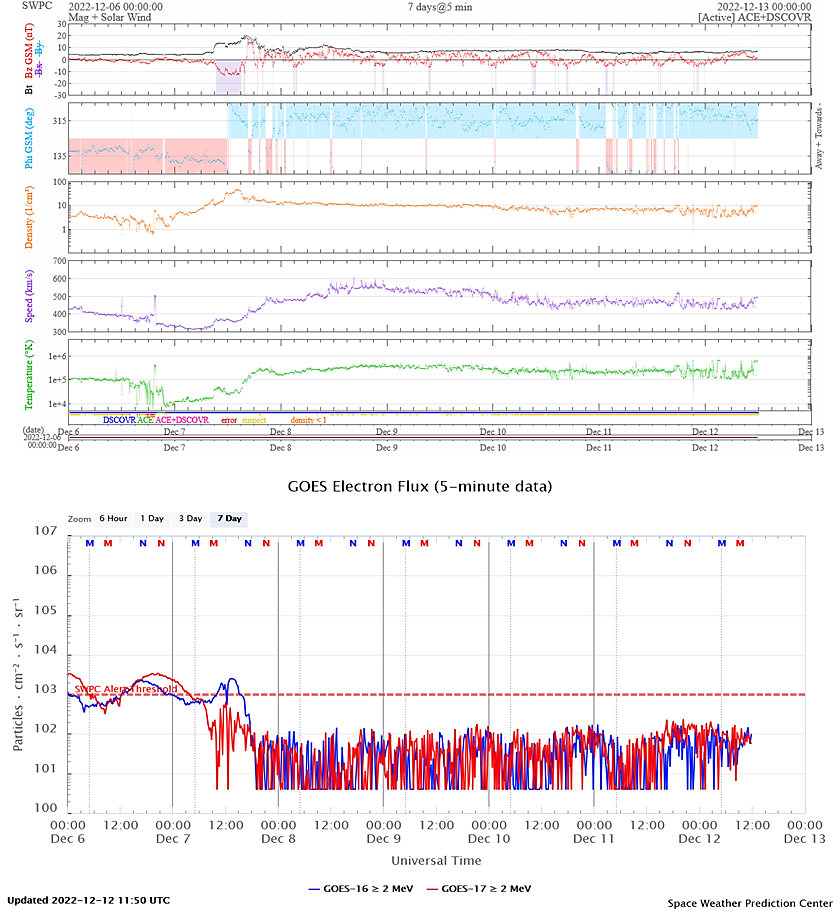
The coronal hole responsible for the recorded high speed stream crossed the central meridian of the Sun (the "north-south" line) on 4 December, and was already approaching the solar west limb by 8 December as indicated on the extreme ultraviolet (EUV) images underneath (SDO/AIA 193 - https://sdo.gsfc.nasa.gov/data/aiahmi/ ). A new coronal hole located in the eastern solar hemisphere, as indicated by the dashed lines, seemed to ready itself to cross the central meridian a few days later. At first sight, it looked like a smaller and more stretched version of the previous coronal hole. However, a closer examination of the EUV images as well as of images made by Hydrogen-alpha filters (656.3 nm; Kanzelhöhe Observatory - http://cesar.kso.ac.at/ ) revealed that this was not a coronal hole.
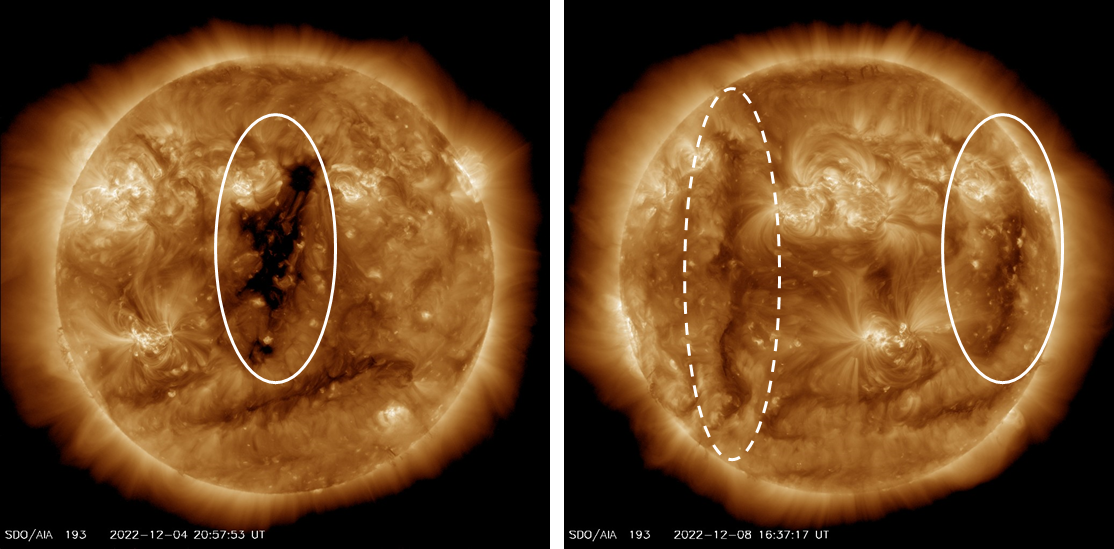
The feature highlighted by the dashed white ellipse in the image above is called a filament channel. A filament channel corresponds to a plasma volume where the magnetic field is primarily aligned with the polarity inversion line (PIL), i.e. the line separating areas of opposite magnetic polarity. The key feature of a filament channel is that it is a region of dominant horizontal field (not vertical or "incoming/outgoing") where the field on either side of the PIL points in the same direction. Filament channels are the unique sites of filament formation. Solar filaments are clouds of charged particles ("plasma") above the solar surface squeezed between magnetic regions of opposite polarity. Being cooler and denser than the plasma underneath and their surroundings, they appear as dark lines when seen on the solar disk and as bright blobs when seen near the solar limb (then they are called "prominences").
Channels are more fundamental than the filaments that form within them, as not every channel contains a filament and a single channel may survive a succession of filament formations and eruptions. The darkish hue of these filament channels is due to absorption of EUV lines in cool plasma condensations that are not observed in Hydrogen-alpha. Underneath is a side-by-side comparison in EUV and in H-alpha, showing the structure on 8 December, clearly indicating the presence of a filament, and thus that this structure was not a coronal hole and that there was no high speed stream en route to Earth. The full disk images also show some other filament channels (containing filaments) in particular near the north solar pole and in the southwest solar quadrant.
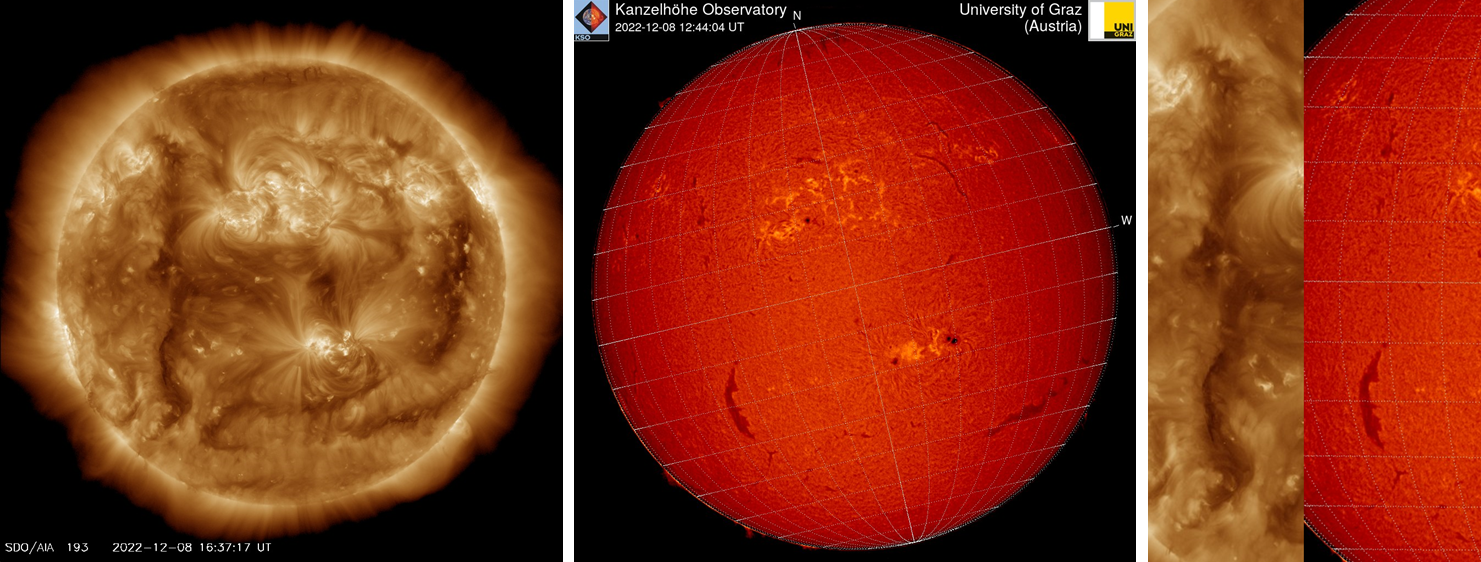
The filament restructured itself during the early morning hours (between 04 and 10UTC) of 9 December, completely disappearing in H-alpha. A clip of this event can be seen in the online version of this newsitem https://www.stce.be/news/618/welcome.html ), with the H-alpha imagery from the GONG network (https://gong.nso.edu/ ). The cadence in EUV is one image every 3 minutes, in H-alpha it is one image every 11 minutes. The "eruption" was not associated with a coronal mass ejection. The filament channel was not destroyed by this event, and gradually started to fill itself again during the subsequent days.
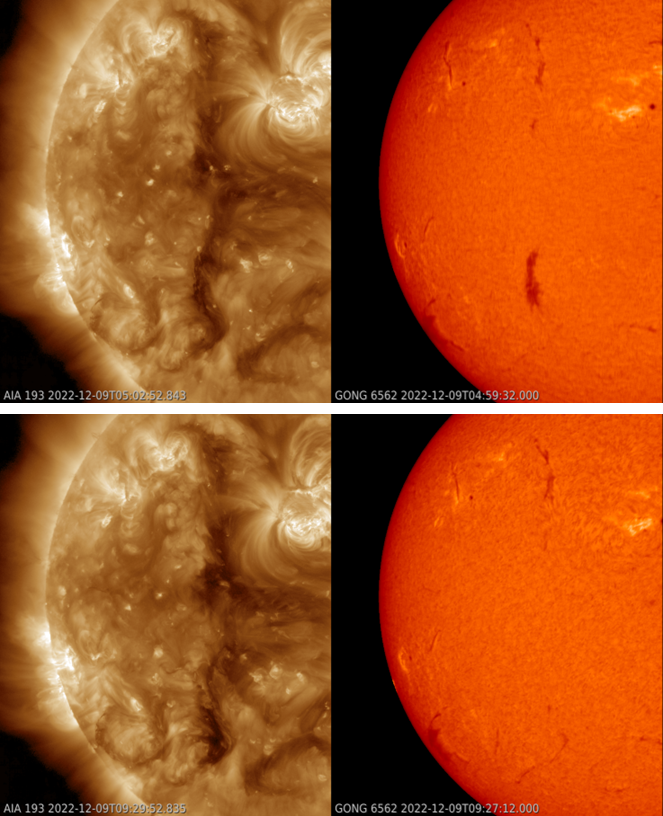
Some additional information on filament channels can be found in Li et al. (2022 -
https://www.aanda.org/articles/aa/full_html/2022/07/aa43115-22/aa43115-22.html ), Mackay et al. (2010 - https://link.springer.com/content/pdf/10.1007/s11214-010-9628-0 ), and Aulanier et al. (2002 - https://www.aanda.org/articles/aa/abs/2002/18/aa2131/aa2131.html ).
Tenth Call for PROBA2 Guest Investigator Program
The PROBA2 PI-team welcomes research proposals for the tenth round of its Guest Investigator program for research based on SWAP and LYRA data analysis by scientists outside the SWAP and LYRA PI-teams. In this round we anticipate funding for around five guest investigators or teams who will visit the PROBA2 Science Center at the Royal Observatory of Belgium, in Brussels, between February 2023 and December 2023.
Selected proposers will be invited to spend a few weeks with the PI teams to obtain expert knowledge on the instruments, to specify observation campaigns according to the needs of their proposal, and to conduct their research. During the selection process, special consideration will be given to early-career scientists and PhD students, collaborative research teams with members from more than one research institute, to proposals that are closely aligned with the research topics in the call, and to proposals that appear likely to lead to publications. We welcome projects combining the PROBA2 payload with other instruments such as the EUI telescopes onboard Solar Orbiter.
More info can be found in the full call: https://proba2.sidc.be/TenthGICall
Deadline: 31 January 2023
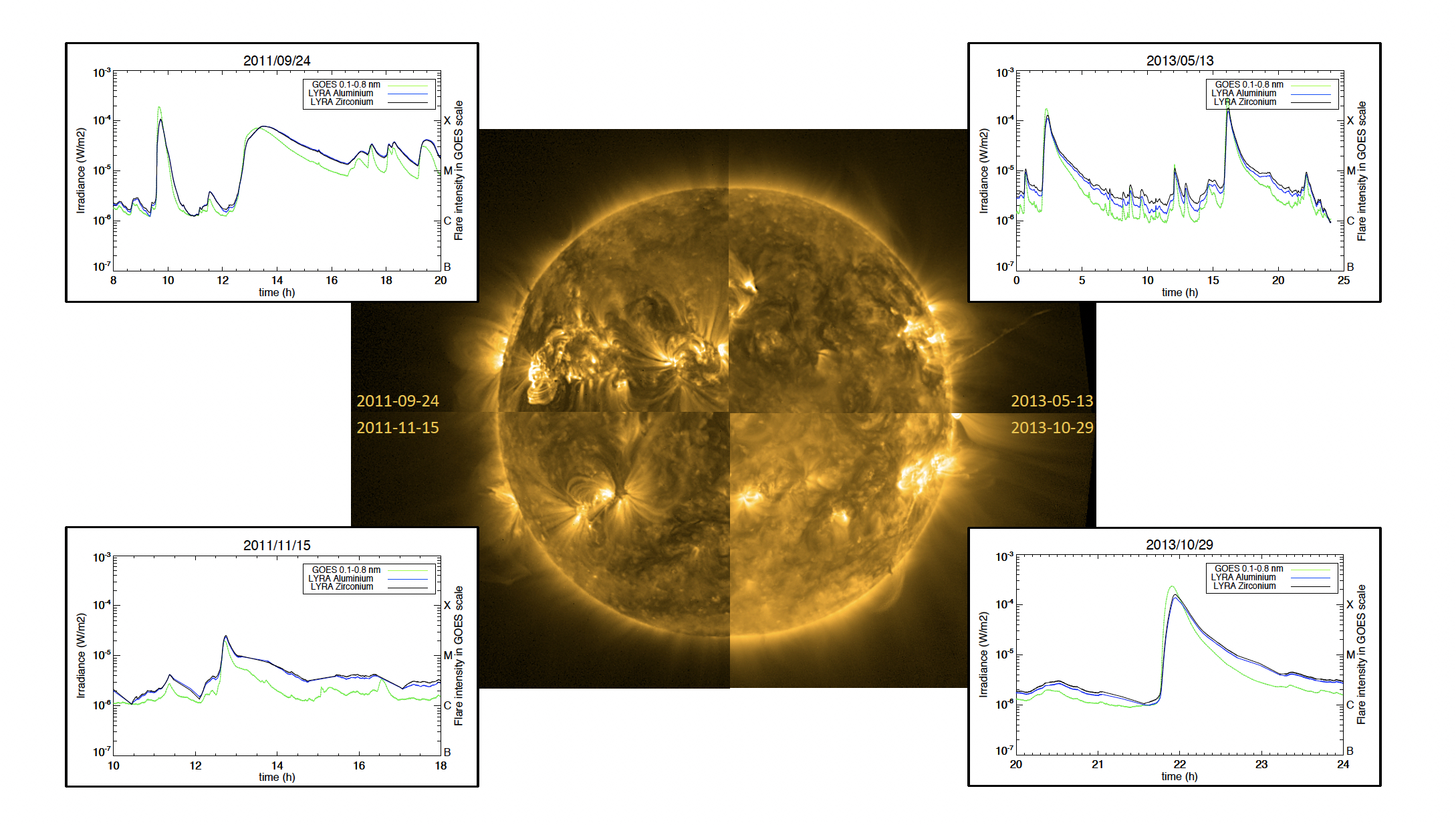
Review of solar activity
Solar Flares
Over the past week the solar flaring activity was at low levels with mostly low C-class flaring. There were ten numbered active regions on the visible disk, that produced 39 C-class flares. The largest flare over the week was a C6.0 flare, peaking at 14:13 UTC on Dec 09 associated with the AR behind the east limb (S19E89).
Solar Wind Disturbances
A filament in the southeast quadrant began to erupt from 06:19UTC on Dec 09 as in SDO/AIA 304. Another filament eruption was seen from the southeast of the Sun at around 12:38UTC on Dec 11. No Coronal Mass Ejections (CMEs) were associated with these events. No other Earth directed CMEs were detected in the available coronagraph imagery.
On Dec 04 a large trans-equatorial negative polarity coronal hole was transiting the central meridian.
Energetic Particles near Earth
The greater than 10 MeV proton flux was at background levels.
The greater than 2 MeV electron flux was above the 1000 pfu threshold for the first half of the week. The 24h electron fluence decreased from high to moderate levels on Dec 04. It remained at a moderate level until Dec 08. For the rest of the week the 24h electron fluence was at normal level.
Review of geomagnetic activity
The solar wind parameters reflected the waning influence of a high-speed stream at the start of the week. The solar wind speed showed a gradually decreasing trend, slowing down from 520 km/s to values around 320 km/s.
At the start of the week, the Earth was situated in a positive sector with the magnetic field was directed away from the Sun.
A high-speed stream from a negative polarity coronal hole began to influence the Earth from Dec 07. The solar wind became slightly disturbed as the total interplanetary magnetic field (IMF) rose to 20 nT on 07 Dec, decreasing to 8 nT on Dec 08. The Bz component ranged between -13 nT and 14 nT. The solar wind velocity followed an increasing trend, rising from 320 km/s on Dec 07 to 550 km/s on Dec 08.
For the rest of the week, the Earth was in the negative sector with the IMF towards the Sun. The solar wind speed remained slightly enhanced for the rest of the week with values between 450 and 550 km/s.
Geomagnetic conditions were at quiet to active levels at the beginning of the week, reducing to quiet on Dec 06. From 09:00UTC Dec 07 to 03:00UTC Dec 09, during the height of the influence of the high-speed stream, the conditions were mostly unsettled to active with isolated periods of minor storm levels. From 03:00UTC Dec 09, the geomagnetic conditions reduced from quiet to unsettled levels as the influence of the high-speed stream began to wane.
PROBA2 Observations (5 Dec 2022 - 11 Dec 2022)
Solar Activity
Solar flare activity was low during the week.
In order to view the activity of this week in more detail, we suggest to go to the following website from which all the daily (normal and difference) movies can be accessed: https://proba2.oma.be/ssa
This page also lists the recorded flaring events.
A weekly overview movie (SWAP week 663) can be found here: https://proba2.sidc.be/swap/data/mpg/movies/weekly_movies/weekly_movie_2022_12_05.mp4.
Details about some of this week's events can be found further below.
If any of the linked movies are unavailable they can be found in the P2SC movie repository here: https://proba2.oma.be/swap/data/mpg/movies/.
Thursday December 08
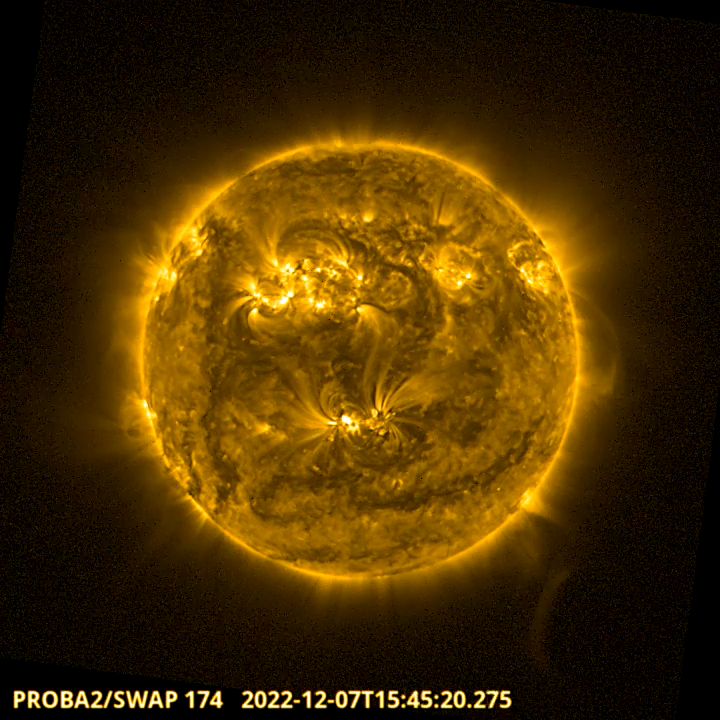
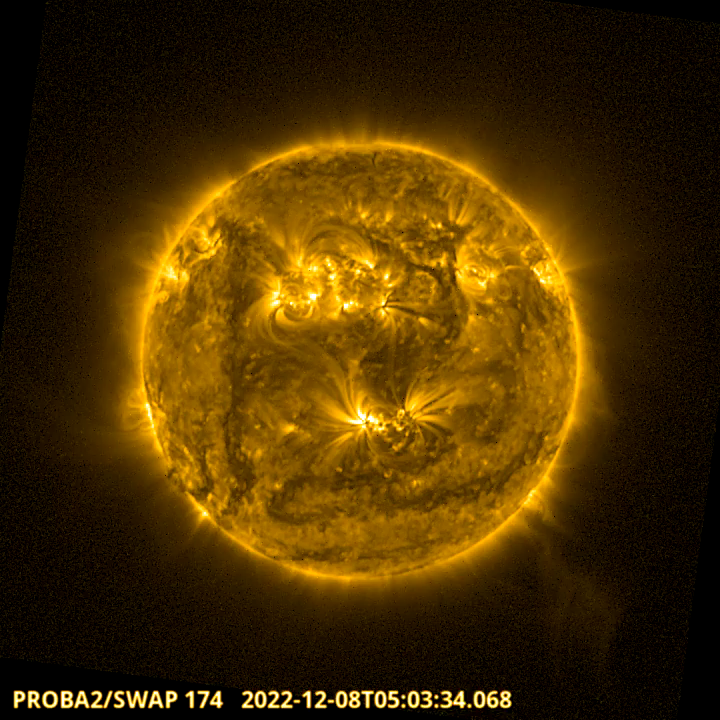
No major flares were recorded this week, so the solar activity was dominated by filament/prominence eruptions. The SWAP images above show observations during the slow rising phase (top panel) and during eruption (bottom panel) of one of the largest filament eruptions of this week, occurring between 7 and 8 December 2022, at the south-western limb of the Sun.
Find a SWAP movie of the event here: https://proba2.sidc.be/swap/movies/20221208_swap_movie.mp4.
The International Sunspot Number by SILSO
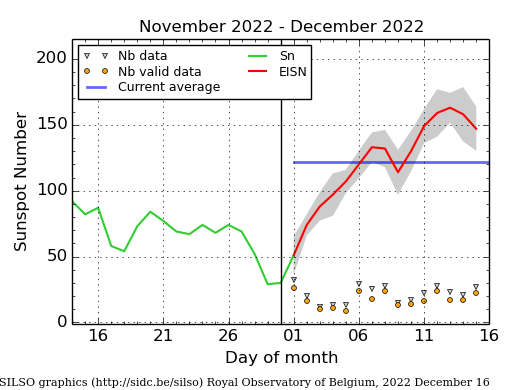
The daily Estimated International Sunspot Number (EISN, red curve with shaded error) derived by a simplified method from real-time data from the worldwide SILSO network. It extends the official Sunspot Number from the full processing of the preceding month (green line), a few days more than one solar rotation. The horizontal blue line shows the current monthly average. The yellow dots give the number of stations that provided valid data. Valid data are used to calculate the EISN. The triangle gives the number of stations providing data. When a triangle and a yellow dot coincide, it means that all the data is used to calculate the EISN of that day.
Geomagnetic Observations in Belgium (5 Dec 2022 - 11 Dec 2022)
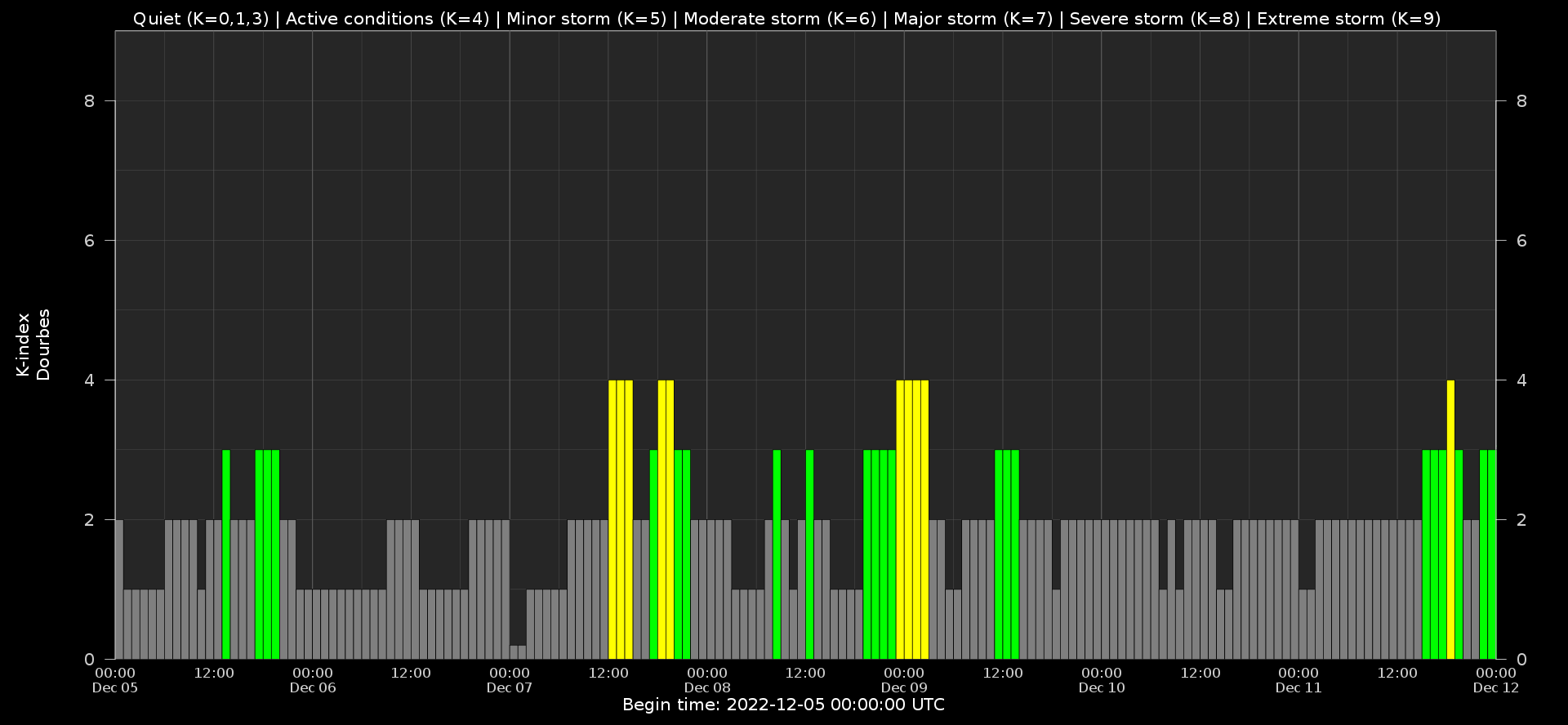
Local K-type magnetic activity index for Belgium based on data from Dourbes (DOU) and Manhay (MAB). Comparing the data from both measurement stations allows to reliably remove outliers from the magnetic data. At the same time the operational service availability is improved: whenever data from one observatory is not available, the single-station index obtained from the other can be used as a fallback system.
Both the two-station index and the single station indices are available here: http://ionosphere.meteo.be/geomagnetism/K_BEL/
The SIDC Space Weather Briefing
The Space Weather Briefing presented by the forecaster on duty from Dec 4 to 11 . It reflects in images and graphs what is written in the Solar and Geomagnetic Activity report: https://www.stce.be/briefings/20221212_SWbriefing.pdf
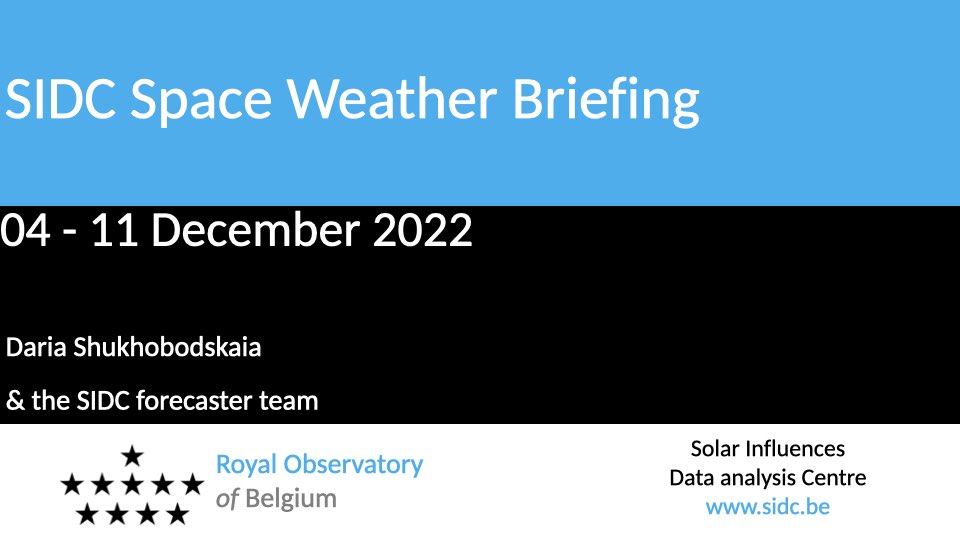
If you need to access the movies, contact us: stce_coordination at stce.be
Things to do
Check out our activity calendar: activities and encounters with the Sun-Space-Earth system and Space Weather as the main theme. We provide occasions to get submerged in our world through educational, informative and instructive activities.
If you want your event in our calendar, contact us: stce_coordination at stce.be
* December 16, Seminar: Tipping of the Atlantic Ocean Circulation, onsite and online, RMI
* December 19, school presentation ‘Noorderlicht, hemelse wetenschap en spannende verhalen’, Kortrijk-Dutsel, Belgium
* January 27, POSTPONED Seminar: Opportunities of Wikipedia and related applications for science, BIRA-IASB
* January 30, 31, February 2, 3, Space Weather Introductory Course - online, by the STCE, zoom
* March 27-29, Space Weather Introductory Course - onsite, by the STCE, Brussels, Belgium
* May 22-24, Space Weather Introductory Course - onsite, by the STCE, Brussels, Belgium
Check: https://www.stce.be/calendar
